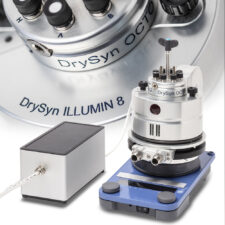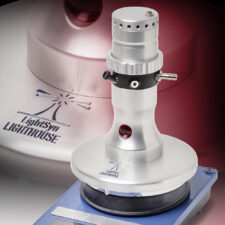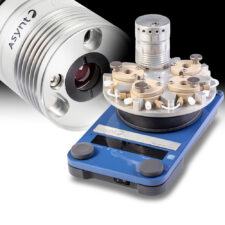The idea of using light as a chemical reagent for fine chemical synthesis has always been exciting due to its low cost and high energy efficiency.1 The challenge was finding ways to scale up production. Now, with bright, efficient LEDs and highly versatile, flexible and efficient LED photoreactors, such as Asynt’s LightSyn Illumin8 Parallel Photoreactor, the reality of sustainable chemical production at scale is here.
Modularity
One of the challenges for LED photoreactors is to have a single instrument that can perform a range of different kinds of reactions. The benefits of using LED photoreactors for synthesis are clear, though – they offer a less energy-intensive route to product formation than traditional thermal methods, and unique fine chemicals can be generated via photoinduced pathways.
However, finding a generally suitable LED photoreactor can be challenging. This is because carrying out various reaction types will mean dealing with different reagents with different absorption wavelengths. Still, it may be necessary to ensure similar irradiation conditions. Some compounds will need to be excited at different wavelengths, and there may even need to be substantial variation in reaction volumes to achieve optimum yields in the LED photoreactor.2
The question is how to design an LED photoreactor that works for everyone. We have the answer – modularity.
Modularity in an LED photoreactor means customising the system to meet the specific requirements of the reactions to be performed. Modularity is at the heart of the Illumin8 Parallel Photoreactor design, making it possible to adapt the reactor precisely to your needs.
Reactor Design
An LED photoreactor generally consists of the LED light source, which is often a bank of multiple LEDs in a specific geometric arrangement around the reaction tube, and the reactor itself which may have a particular shape and diameter.3 The complexity of reactor designs can vary significantly from single channels to multiple capillaries running in parallel or columns. Other considerations may be the type of pumps used and the material the reactor is made from.4 Some particularly corrosive chemical reactions will not be suitable to carry out in all reactor types.
The LightSyn Illumin8 LED photoreactor is built around the popular 8-position reaction station, DrySyn OCTO-MINI. The Illumin8 LED modules, which enable the photochemical reactions, feature a set of eight 10 W LEDs. The LEDs are positioned evenly around each reaction tube position where the photochemistry can occur. What makes the Illumin8 LED photoreactor so versatile is that the LED modules can be swapped out as part of one cartridge – 8 x less work than removing each individually.
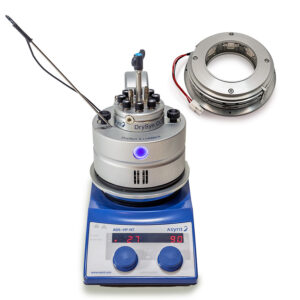
Popular options include royal blue (450 nm), UV (365 nM), UVA (390-395 nm), violet (405 nm), green (520-525 nm) and deep red (650-660 nm), with other wavelengths available. The cartridge is designed primarily in this LED photoreactor to ensure an even photon flux to every reaction position.
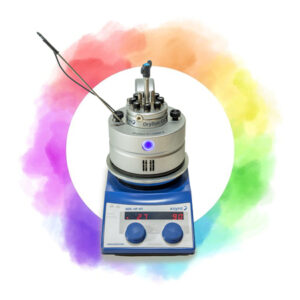
With these easily interchangeable COB (chip-on-board) LED cartridge modules, the LightSyn Illumin8 is a flexible LED photoreactor, suitable for a wide range of reactions. It allows users to optimise the wavelength conditions for specific reactions, in parallel, for volumes of up to 10 mL, however, the system can be used for volumes as low as 1 mL.
The ingenious design of the LightSyn Illumin8 LED photoreactor enables users to combine the system with existing apparatus such as different brands of magnetic hotplate stirrer, and is simple to set up and use. Some examples of reactions successfully optimised with the Illumin8 LED photoreactor include decarboxylative fluorination and radical additions with very high yields.
The whole design incorporates multiple safety interlocks to ensure excellent light safety, and there is a cooling fan within the head of the Illumin8. An optional heating/cooling base is offered to maintain a constant temperature in all the reaction tubes under continual radiation. It ensures safe and consistent operating conditions, as other components, such as the magnetic drive, can also contribute to heating during the reaction.
Contact us today to discover how modular LED photoreactors could enhance your photochemical synthesis, whether at the laboratory or the industrial scale.
References and Further Reading
- Esser, P., Pohlmann, B., & Scharf, H. ‐D. (1994). The Photochemical Synthesis of Fine Chemicals with Sunlight. Angewandte Chemie International Edition in English, 33(20), 2009–2023. https://doi.org/10.1002/anie.199420091
- McCullagh, C., Skillen, N., Adams, M., & Robertson, P. K. J. (2011). Photocatalytic reactors for environmental remediation: A review. Journal of Chemical Technology and Biotechnology, 86(8), 1002–1017. https://doi.org/10.1002/jctb.2650
- Kayahan, E., Jacobs, M., Braeken, L., Thomassen, L. C. J., Kuhn, S., Van Gerven, T., & Leblebici, M. E. (2020). Dawn of a new era in industrial photochemistry: The scale-up of micro: The mesostructured photoreactors. Beilstein Journal of Organic Chemistry, 16, 2484–2504. https://doi.org/10.3762/BJOC.16.202
- Variar, A. G., Ramyashree, M. S., Ail, V. U., S., S. P., Sudhakar, K., & Tahir, M. (2021). Influence of various operational parameters in enhancing photocatalytic reduction efficiency of carbon dioxide in a photoreactor: A review. Journal of Industrial and Engineering Chemistry, 99, 19–47. https://doi.org/10.1016/j.jiec.2021.04.017
